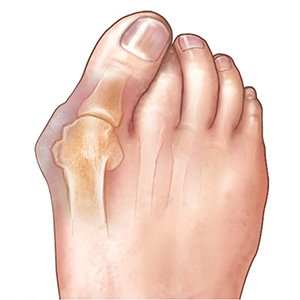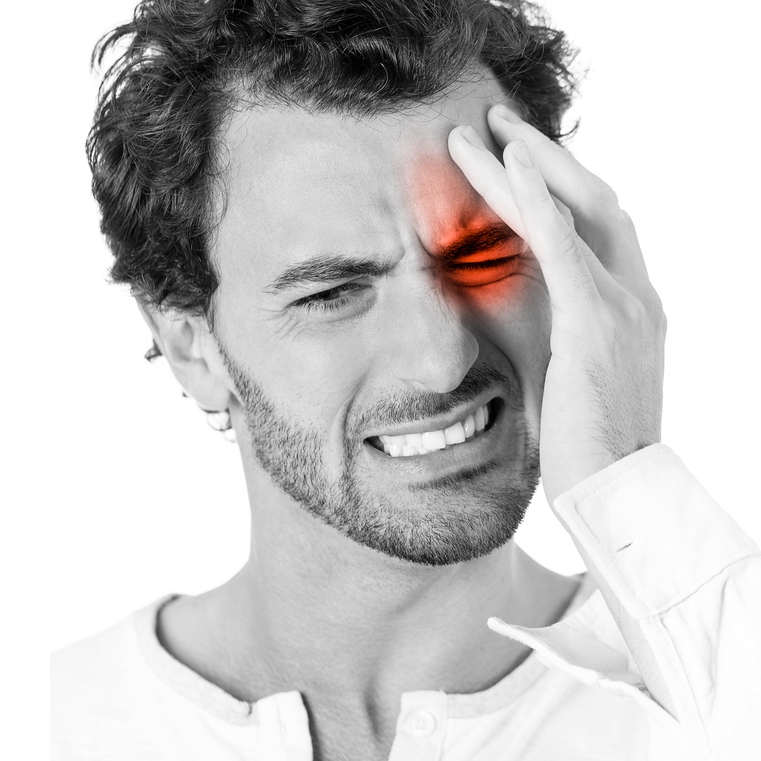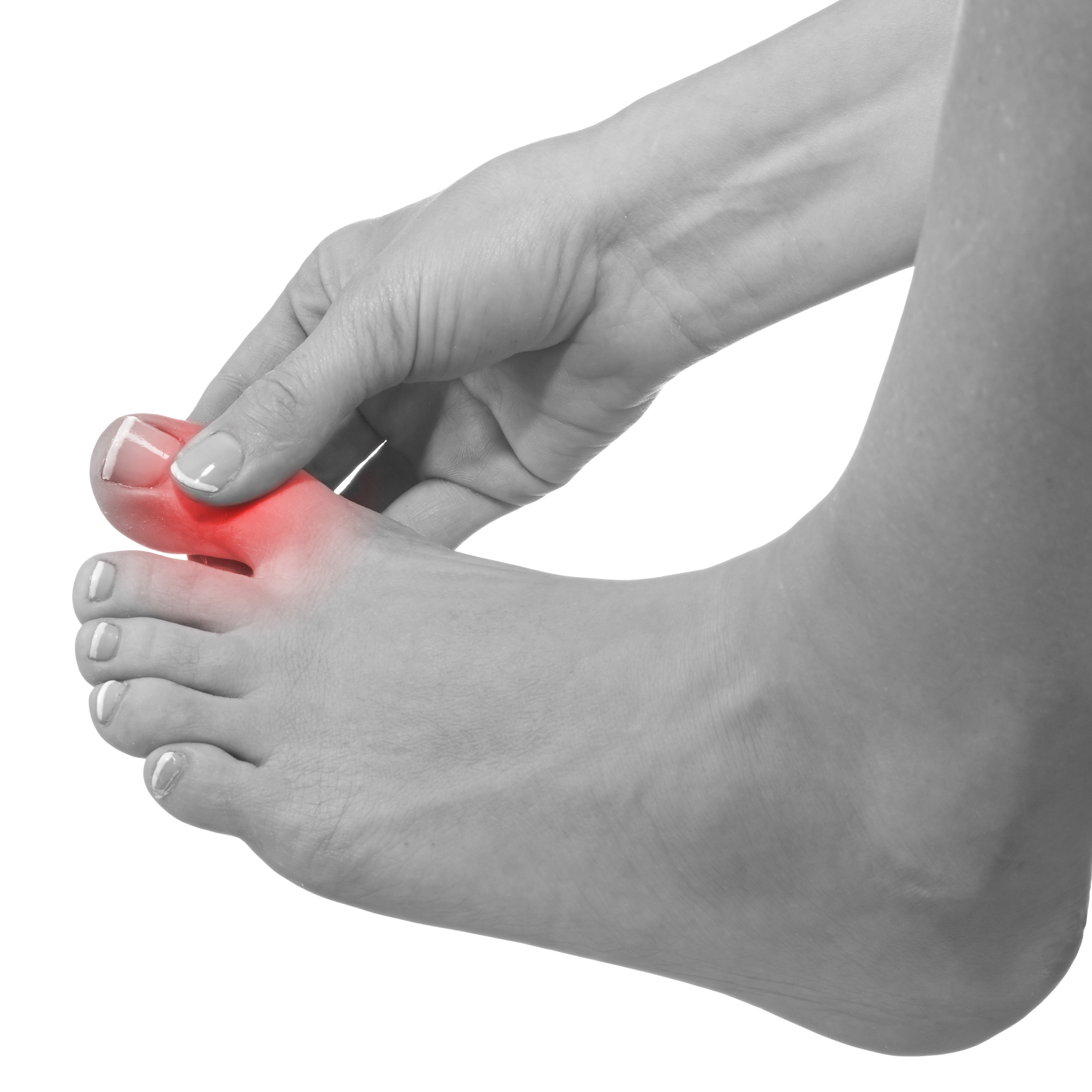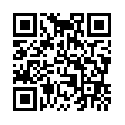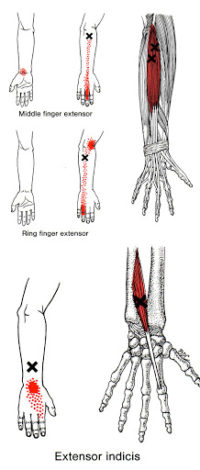 The extensors of the fingers include extensor indicis, extensor digitorum, and extensor digiti minimi. Collectively they extend all four fingers of the hand at the knuckle and finger joints. They are grouped together here because their location, function, and activations are similar. Their chief function is to extend the fingers and to provide a balanced to make the grasp of individual fingers possible. They are essential for a strong grasp.
The extensors of the fingers include extensor indicis, extensor digitorum, and extensor digiti minimi. Collectively they extend all four fingers of the hand at the knuckle and finger joints. They are grouped together here because their location, function, and activations are similar. Their chief function is to extend the fingers and to provide a balanced to make the grasp of individual fingers possible. They are essential for a strong grasp.
 The extensor indicis extends the index finger. The extensor digitorum extends all the fingers but primarily extends the 3rd and 4th fingers. The extensor digiti minimi extends both the 5th finger and the elbow joint.
The extensor indicis extends the index finger. The extensor digitorum extends all the fingers but primarily extends the 3rd and 4th fingers. The extensor digiti minimi extends both the 5th finger and the elbow joint.
Symptoms include weakness as well as pain, tenderness, and stiffness in the hand and fingers. The finger involved corresponds to its primary extensor. They occur on the outside of the forearm, near the elbow, and progress down the arm toward the base of the thumb and hand. You may wake up at night from pain, drop objects, and have trouble with fine motor skills such as handwriting.
 Finger extensor trigger points are typically activated from a combination of repetitive finger motion, forceful gripping, or improper twisting movements. This can include activities as diverse as weeding, playing piano, or handwriting. Once initial soreness develops, the tendency to “test” the muscle for improvement tends to worsen it.
Finger extensor trigger points are typically activated from a combination of repetitive finger motion, forceful gripping, or improper twisting movements. This can include activities as diverse as weeding, playing piano, or handwriting. Once initial soreness develops, the tendency to “test” the muscle for improvement tends to worsen it.
Corrective actions include trigger point pressure release, stretching, and avoiding activities that overload the muscle.
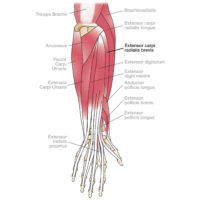 Pain may be identified with “tennis elbow” or arthritis of the fingers when the cause actually is trigger points in the finger extensors. The pain can be severe enough to interrupt sleep. Pain the extensor indicis typically only extends from the index finger into the back of the hand and does not involve the arm.
Pain may be identified with “tennis elbow” or arthritis of the fingers when the cause actually is trigger points in the finger extensors. The pain can be severe enough to interrupt sleep. Pain the extensor indicis typically only extends from the index finger into the back of the hand and does not involve the arm.
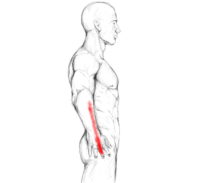 When the extensor digitorum is involved alone, there may be a weakness of grip without pain. The finger extensors are crucial to a strong grip, so any symptoms of finger flexion issues may point back to the finger extensors. Weakness can be so severe that you cannot open an unsealed jar or grasp a carton of milk, for instance.
When the extensor digitorum is involved alone, there may be a weakness of grip without pain. The finger extensors are crucial to a strong grip, so any symptoms of finger flexion issues may point back to the finger extensors. Weakness can be so severe that you cannot open an unsealed jar or grasp a carton of milk, for instance.
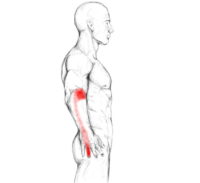 The two patterns pictured relate to trigger points referring to the 3rd and 4th fingers.
The two patterns pictured relate to trigger points referring to the 3rd and 4th fingers.
Handshakes that are painful at the elbow suggest trigger points in the extensors of the 4th and 5th fingers.
Trigger points in the thumb extensors usually manifest in limited range of motion without pain.
For all the finger extensors, there can also be pain and stiffness of the finger joints closer to the hand.
 Dysfunction of the finger extensors and thumb extensor can also cause a lack of coordination, making typing, writing, or other fine motor tasks difficult.
Dysfunction of the finger extensors and thumb extensor can also cause a lack of coordination, making typing, writing, or other fine motor tasks difficult.
Finger extensor dysfunction will limit the range of finger flexion.  Figure A is normal. In figure B, some individual extensors are restricted and in figure C, all of them are restricted.
Figure A is normal. In figure B, some individual extensors are restricted and in figure C, all of them are restricted.
Finger extensor trigger points usually do not happen in isolation and are part of a pattern that includes the finger flexors, wrist flexors, and wrist extensors. and wrist flexors.
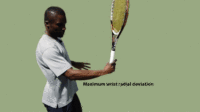 Avoid repetitive actions that overload the muscle with your wrist flexed or deviated towards your pinky, such as excessive hand flexion/gripping. A significant period of rest and recovery may be needed.
Avoid repetitive actions that overload the muscle with your wrist flexed or deviated towards your pinky, such as excessive hand flexion/gripping. A significant period of rest and recovery may be needed.
You may consider adapting by deliberately rotating at the shoulder at times rather than moving your wrist.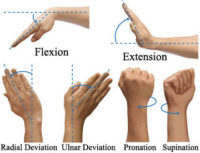
Limit flexion and ulnar deviation of the wrist. Limit forceful rotation of the arm and rapid flexion/extension of the elbow. In sports activities, deliberately deviate your wrist toward the thumb side of your hand.
Grasping jars, doorknobs, or tools with your fingers instead of your entire hand overloads the finger extensors and can activate trigger points.
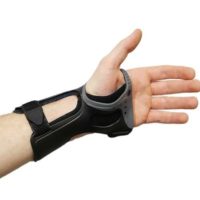 When engaging in activities involving forceful twisting motions or wrist flexion, consider using a wrist guard similar to below. They are often sold for carpal tunnel syndrome.
When engaging in activities involving forceful twisting motions or wrist flexion, consider using a wrist guard similar to below. They are often sold for carpal tunnel syndrome.
Resist the urge to “test” the painful motions during the initial rest and recovery phase. Gradually resuming a variety of activities gradually is usually better than trying to condition individual muscles without assistance.
Myofascial self-care always starts with establishing a foundation of diaphragmatic breathing. Once you have taken a few moments to get in touch with your breath, we move on to self-compression and stretching. You may find that a warm bath or shower, or applying moist heat before you begin is helpful.
 You can use pressure self-release for the wrist extensors while seated or standing.
You can use pressure self-release for the wrist extensors while seated or standing.
Using your hand from the unaffected side, begin by using your fist to gently massage the top of the forearm. Explore the muscles, note areas that are sorer, and bring your focus to them.

To compress specific trigger points, use the knuckle (or thumb) of the forefinger from the unaffected side to probe deeper. Find the tender spot and apply pressure for up to 30 seconds as pain decreases. You can do this three to five times.
Many blood vessels and nerves in the arm are superficial, so pressure self-release should be done with caution. If you feel tingling or circulation changes in your hand you should reposition and take a different approach.
After completing self-compressions, move your wrist through its range of motion and prepare to gently stretch your finger extensors.
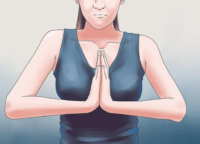
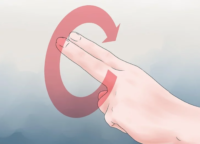
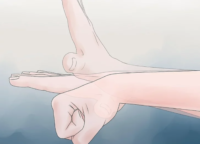
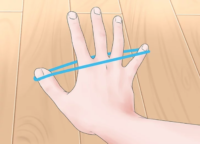
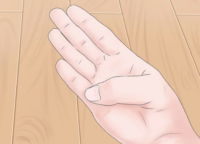
You can use your breath to deepen the wrist extensor stretch shown. Note that the fingers are extended in this stretch. You may also stretch with a loose fist, although this stretches the extensors of the fingers, not the wrist.
If you experience pain following pressure release and stretching, a cold pack may be helpful.
The 40-minute video below discusses the treatment of hand and finger pain from a physical therapy perspective, including the use of a hand massage called the iPalm:
 If you maintain a posture or activity that activates a trigger point in any muscle it will continue.
If you maintain a posture or activity that activates a trigger point in any muscle it will continue.
Finger extensor trigger points are typically activated from repetitive, forceful finger movements. This includes carpenters, plumbers and electricians, mechanics, and diligent student and professional musicians, especially pianists.
Incidental causes of trigger point activation include local injury or infection of a finger, fracture, and/or immobilization of the forearm.
The extensor digiti minimi (connected to the pinky) is usually not considered separately because it is often tied to dysfunction in the extensor digitorum.
Extensor pollicis (connected to the thumb) typically develops trigger points in connection with the other finger extensors. However, it can also develop trigger points that restrict its pain-free range of motion away from the palm.
 The extensor digitorum muscle extends the phalanges, then the wrist, and finally the elbow. It tends to separate the fingers as it extends them.
The extensor digitorum muscle extends the phalanges, then the wrist, and finally the elbow. It tends to separate the fingers as it extends them.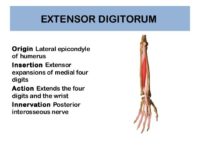
In the fingers, the extensor digitorum acts principally on the proximal phalanges, acting to extend the metacarpophalangeal joint. Extension of the proximal and distal interphalangeal joints, however, is mediated predominantly by the dorsal and palmar interossei and lumbricals of the hand.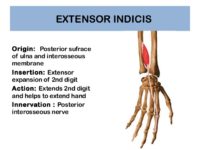
The extensor indicis extends the index finger, and by its continued action assists in extending the wrist and the midcarpal joints.
The extensor digiti minimi is a two-joint muscle. It acts as an extensor in both joints. It extends the wrist, which means it moves the back of the hand toward the back of the forearm. It also extends the little finger, which means it straightens the little finger from a fist.
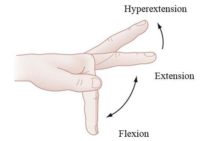 Because the index finger and little finger have separate extensors, these fingers can be moved more independently than the other fingers.
Because the index finger and little finger have separate extensors, these fingers can be moved more independently than the other fingers.
Extensor pollicis longus extends the tip of the thumb. While abductor pollicis brevis and adductor pollicis, both attached to the extensor pollicis longus tendon, can extend the thumb’s middle joint to the neutral position, only extensor pollicis longus can achieve full hyperextension at the middle joint.
It also applies an extensor force at the metacarpophalangeal joint together with the extensor pollicis brevis and extends and adducts at the carpometacarpal joint of the thumb.
In a close relationship to the abductor pollicis longus, the extensor pollicis brevis both extends and abducts the thumb at the carpometacarpal and metacarpophalangeal joints.
 There are three primary finger extensors and two extensors of the thumb.
There are three primary finger extensors and two extensors of the thumb.
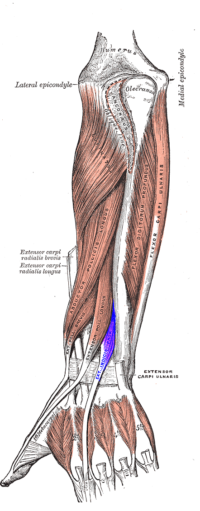 Extensor indicis arises from the lower third of the top part of the ulna and from the interosseous membrane. It runs through the fourth tendon compartment together with the extensor digitorum, from where it projects into the dorsal (top) aponeurosis (flat tendon) of the index finger.
Extensor indicis arises from the lower third of the top part of the ulna and from the interosseous membrane. It runs through the fourth tendon compartment together with the extensor digitorum, from where it projects into the dorsal (top) aponeurosis (flat tendon) of the index finger.
Opposite the head of the second metacarpal bone, it joins the ulnar side of the tendon of the extensor digitorum which belongs to the index finger.
Like the extensor digiti minimi (i.e. the extensor of the little finger), the tendon of the extensor indicis inserts on the ulnar side of the tendon of the common extensor digitorum. The extensor indicis lacks the tendinous band interlinking the tendons of the extensor digitorum on the dorsal side of the hand.
 The extensor digitorum muscle arises from the lateral epicondyle of the humerus, by the common tendon; from the intermuscular septa between it and the adjacent muscles, and from the antebrachial fascia (forearm fascia). It divides below into four tendons, which pass, together with that of the extensor indicis, past the wrist. The tendons then diverge on the back of the hand and are inserted into the middle and furthest segments of the fingers.
The extensor digitorum muscle arises from the lateral epicondyle of the humerus, by the common tendon; from the intermuscular septa between it and the adjacent muscles, and from the antebrachial fascia (forearm fascia). It divides below into four tendons, which pass, together with that of the extensor indicis, past the wrist. The tendons then diverge on the back of the hand and are inserted into the middle and furthest segments of the fingers.
After having crossed the wrist joint, it spreads out into a broad aponeurosis (flat tendon), which covers the dorsal surface of the index finger and is reinforced by the tendons of the interossei and lumbricalis.
The remainder of this aponeurosis divides into three slips. The first is inserted into the base of the middle finger; and the other two form a web that inserts into the top of the 3rd, 4th, and 5th fingers.
These extensor tendons to each finger are connected by a thin transverse band that serves to maintain the central alignment of the extensor tendons over the hand, increasing available leverage.
The extensor digiti minimi is a slender muscle in the forearm on the ulnar (pinky) side of the extensor digitorum.
It arises from the common extensor tendon by a thin tendinous slip and frequently from the intermuscular septa between it and the adjacent muscles.
Its tendon passes through a compartment of the extensor retinaculum, then divides into two as it crosses the top of the hand, and finally joins the extensor digitorum tendon. All three tendons attach to the top of the fifth digit (little finger). There may be a slip of tendon to the fourth digit.
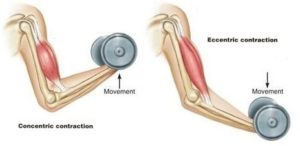 For example, in a biceps curl, you would use a concentric contraction of your biceps, coupled with an eccentric contraction of your triceps, to flex your elbow and push the weight up. As you lower the weight, eccentric contractions of your biceps are required to maintain control and prevent dropping the weight.
For example, in a biceps curl, you would use a concentric contraction of your biceps, coupled with an eccentric contraction of your triceps, to flex your elbow and push the weight up. As you lower the weight, eccentric contractions of your biceps are required to maintain control and prevent dropping the weight.
Isotonic Contractions
Isotonic contractions maintain constant tension in the muscle as the muscle changes length. This can occur only when a muscle’s maximal force of contraction exceeds the total load on the muscle. Isotonic muscle contractions can be either concentric (muscle shortens) or eccentric (muscle lengthens).Concentric Contractions
A concentric contraction is a type of muscle contraction in which the muscle shortens while generating force. This is typical of muscles that contract due to the sliding filament mechanism, and it occurs throughout the muscle. Such contractions also alter the angle of the joints to which the muscles are attached.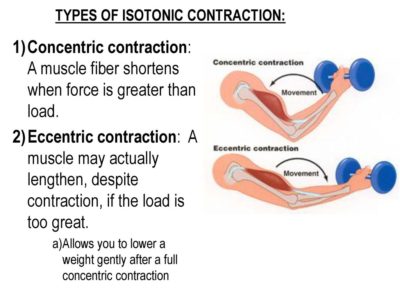 This occurs throughout the length of the muscle, generating force; causing the muscle to shorten and the angle of the joint to change. For instance, a concentric contraction of the biceps would cause the arm to bend at the elbow as the hand moves close to the shoulder (a biceps curl).
A concentric contraction of the triceps would change the angle of the joint in the opposite direction, straightening the arm and moving the hand away from the shoulder.
This occurs throughout the length of the muscle, generating force; causing the muscle to shorten and the angle of the joint to change. For instance, a concentric contraction of the biceps would cause the arm to bend at the elbow as the hand moves close to the shoulder (a biceps curl).
A concentric contraction of the triceps would change the angle of the joint in the opposite direction, straightening the arm and moving the hand away from the shoulder.
Eccentric Contractions
An eccentric contraction results in the lengthening of a muscle. These contractions decelerate muscles and joints (acting as “brakes” to concentric contractions) and can alter the position of the load force. During an eccentric contraction, the muscle lengthens while under tension due to an opposing force that is greater than the force generated by the muscle. However, rather than working to pull a joint in the direction of the muscle contraction, the muscle acts to decelerate the joint at the end of a movement or otherwise control the repositioning of a load. This can occur involuntarily (when attempting to move a weight too heavy for the muscle to lift) or voluntarily (when the muscle is “smoothing out” a movement). Strength training involving both eccentric and concentric contractions appears to increase muscular strength and joint stability more than training with concentric contractions alone.Isometric Contractions
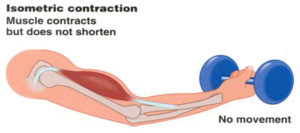 In contrast to isotonic contractions, isometric contractions generate force without changing the length of the muscle. This is typical of muscles found in the hands and forearm: the muscles do not change length, and joints are not moved, so force for grip is sufficient. An example is when the muscles of the hand and forearm grip an object; the joints of the hand do not move, but muscles generate sufficient force to prevent the object from being dropped.
For people with hypermobile joints, strength training can be a challenge. Tension stresses the connective tissues of the joint as force is transmitted through its range of motion. Isometric exercises can be ideal in these circumstances because there is minimal movement. This means that the joint is placed into vulnerable hyperextended positions under force.
In contrast to isotonic contractions, isometric contractions generate force without changing the length of the muscle. This is typical of muscles found in the hands and forearm: the muscles do not change length, and joints are not moved, so force for grip is sufficient. An example is when the muscles of the hand and forearm grip an object; the joints of the hand do not move, but muscles generate sufficient force to prevent the object from being dropped.
For people with hypermobile joints, strength training can be a challenge. Tension stresses the connective tissues of the joint as force is transmitted through its range of motion. Isometric exercises can be ideal in these circumstances because there is minimal movement. This means that the joint is placed into vulnerable hyperextended positions under force.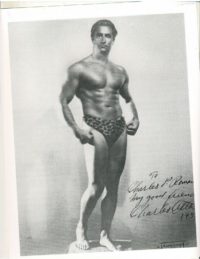 You can develop amazing strength without free weights, machines, or resistance bands.
One of the original bodybuilder gurus from the 1920s, Charles Atlas, based his workouts primarily on isometric exercises, eventually even trademarking a term for his exercise method that he called "Dynamic Tension."
If you have hypermobile joints you can strength train safely at home with isometric exercises.
You can develop amazing strength without free weights, machines, or resistance bands.
One of the original bodybuilder gurus from the 1920s, Charles Atlas, based his workouts primarily on isometric exercises, eventually even trademarking a term for his exercise method that he called "Dynamic Tension."
If you have hypermobile joints you can strength train safely at home with isometric exercises.
Professional Treatment With Us
Take some time. Treat yourself. You deserve it.
Book a treatment this month and receive 20% off a three session package.
Janet was great. FANTASTIC person who knew how to treat and deal with my conditions. Very informative. Finally, someone who knew what I was talking about.
Really Good
It was interesting, and helpful for my IT band and hip
My experience was wonderful. Janet was very kind and attentive. I felt great after my session and would recommend to try it out.
The lady that assisted me was awesome! I suffer from fibromyalgia and when I left I felt like a brand new person! I plan to return when I get time!
Janet was great - knowledgeable and she found all my "hot spots."
Seriously, if you are looking for massage therapy that actually does your body good--that changes its function for the better and actually makes pain go away--then this is the place you need to come. Not Massage Envy. Not a chiropractor. You need trigger point from knowledgeable experts in the craft.
If your have pain in any part of your body this is the place to go. It focus on the muscles where the pain is. you will feel like a new person. Awesome will be returning. Thanks nice friendly and attentive
amazing!!!
I felt so much better after my appointment. Thank you and thanks for the self care tips!
Experienced therapist. Feel great after appointment...
Highly recommended!
What a great experience. The provider was able to recommend things I can do to improve my pain. Address issues I didn't even share with her that she was able to tell just by her exam and treating me for what i went for. Will be back. Feeling grateful
I spent so much money on chiropractors. This is much better. Everybody should try it out.
Beautiful, relaxing setting. Therapist was knowledgable and professional. I'll be going back. Thank you.
Janet is very informative. I loved that she explained which muscles/groups she was working on. I learned a lot about my posture and why some of my muscles are not activating. She also provided me with a list of considerations and excercises to improve my posture. I will be back!
Janet has a unique gift and talent in trigger point therapy. I’m definitely seeing her again!
I loved my experience. Janet is extremely knowledgeable in a vary wide variety of conditions. She is thorough and attentive. Makes you feel right at home!
It's like an hour of physical therapy (the good parts of P.T. where they massage you and stretch you). She also takes time to explain some ways to help your specific issues. Highly recommend!
Janet is very knowledgeable and informative. She thoroughly explains where you have weakness and what muscles are over compensating. She gives exercises, stretches, or everyday changes you can make to help you are progress on your own. I highly recommend a visit!
Janet was very knowledgeable and never in a hurry. She took her time explaining every little detail, great service
Felt much better after the trigger point massage, highly recommend.
Excellent
What About My Pain?
Clearly, everyone is different. Many of us have additional challenges and complications. Naturally, we tailor our treatment plans to the individual. However, there are common foundations in this work with everyone.
Fortunately, if you are having similar issues, you may find that a just few treatment sessions helps! We will identify and treat root causes of your individual case.
Clearly, everyone is different. Many of us have additional challenges and complications. Naturally, we tailor our treatment plans to the individual. However, there are common foundations in this work with everyone.
We are licensed professionals. In addition, we all have additional training and certifications in advanced techniques. For instance, this includes trigger point therapy, fascial stretching, neuromuscular and movement therapy. Also we offer kinesio taping, myofascial release, cupping, acoustic compression, self-care classes and more. In fact, we often combine several of these techniques into a single session..
Of course, no one wants chronic pain! Fortunately, can work together with you to help sort out the issues.
Click here or all us at 630-858-0000 today to make an appointment!
More info at: WestSubPainRelief.com
You can also take a picture of this QR code with another phone and share or view the entire article:
If reading from a pdf or printout, you will find links and videos at: https://WestSubPainRelief.com/finger-extensors

